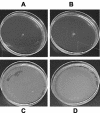Extracellular proteolytic activity plays a central role in swarming motility in Bacillus subtilis
- PMID: 15205417
- PMCID: PMC421602
- DOI: 10.1128/JB.186.13.4159-4167.2004
Extracellular proteolytic activity plays a central role in swarming motility in Bacillus subtilis
Abstract
Natural isolates of Bacillus subtilis exhibit a robust multicellular behavior known as swarming. A form of motility, swarming is characterized by a rapid, coordinated progression of a bacterial population across a surface. As a collective bacterial process, swarming is often associated with biofilm formation and has been linked to virulence factor expression in pathogenic bacteria. While the swarming phenotype has been well documented for Bacillus species, an understanding of the molecular mechanisms responsible remains largely isolated to gram-negative bacteria. To better understand how swarming is controlled in members of the genus Bacillus, we investigated the effect of a series of gene deletions on swarm motility. Our analysis revealed that a strain deficient for the production of surfactin and extracellular proteolytic activity did not swarm or form biofilm. While it is known that surfactin, a lipoprotein surfactant, functions in swarming motility by reducing surface tension, this is the first report demonstrating that general extracellular protease activity also has an important function. These results not only help to define the factors involved in eliciting swarm migration but support the idea that swarming and biofilm formation may have overlapping control mechanisms.
Figures





Similar articles
-
Swarming motility in undomesticated Bacillus subtilis.Mol Microbiol. 2003 Aug;49(3):581-90. doi: 10.1046/j.1365-2958.2003.03584.x. Mol Microbiol. 2003. PMID: 12864845
-
Epr plays a key role in DegU-mediated swarming motility of Bacillus subtilis.FEMS Microbiol Lett. 2009 Jun;295(2):187-94. doi: 10.1111/j.1574-6968.2009.01596.x. Epub 2009 Apr 16. FEMS Microbiol Lett. 2009. PMID: 19416356
-
Genes governing swarming in Bacillus subtilis and evidence for a phase variation mechanism controlling surface motility.Mol Microbiol. 2004 Apr;52(2):357-69. doi: 10.1111/j.1365-2958.2004.03996.x. Mol Microbiol. 2004. PMID: 15066026
-
Regulation of flagellar motility during biofilm formation.FEMS Microbiol Rev. 2013 Nov;37(6):849-71. doi: 10.1111/1574-6976.12018. Epub 2013 Apr 12. FEMS Microbiol Rev. 2013. PMID: 23480406 Free PMC article. Review.
-
Shelter in a Swarm.J Mol Biol. 2015 Nov 20;427(23):3683-94. doi: 10.1016/j.jmb.2015.07.025. Epub 2015 Aug 12. J Mol Biol. 2015. PMID: 26277623 Free PMC article. Review.
Cited by
-
Pyrones Identified as LuxR Signal Molecules in Photorhabdus and Their Synthetic Analogues Can Alter Multicellular Phenotypic Behavior of Bacillus atropheaus.ACS Omega. 2021 Nov 22;6(48):33141-33148. doi: 10.1021/acsomega.1c05508. eCollection 2021 Dec 7. ACS Omega. 2021. PMID: 34901665 Free PMC article.
-
Deleting multiple lytic genes enhances biomass yield and production of recombinant proteins by Bacillus subtilis.Microb Cell Fact. 2014 Aug 31;13:129. doi: 10.1186/s12934-014-0129-9. Microb Cell Fact. 2014. PMID: 25176138 Free PMC article.
-
Release of an HtrA-Like Protease from the Cell Surface of Thermophilic Brevibacillus sp. WF146 via Substrate-Induced Autoprocessing of the N-terminal Membrane Anchor.Front Microbiol. 2017 Mar 21;8:481. doi: 10.3389/fmicb.2017.00481. eCollection 2017. Front Microbiol. 2017. PMID: 28377763 Free PMC article.
-
The PGPR Stenotrophomonas maltophilia SBP-9 Augments Resistance against Biotic and Abiotic Stress in Wheat Plants.Front Microbiol. 2017 Oct 9;8:1945. doi: 10.3389/fmicb.2017.01945. eCollection 2017. Front Microbiol. 2017. PMID: 29062306 Free PMC article.
-
In-depth genome and comparative genome analysis of a metal-resistant environmental isolate Pseudomonas aeruginosa S-8.Front Cell Infect Microbiol. 2025 Feb 27;15:1511507. doi: 10.3389/fcimb.2025.1511507. eCollection 2025. Front Cell Infect Microbiol. 2025. PMID: 40083908 Free PMC article.
References
-
- Allison, C., H. C. Lai, and C. Hughes. 1992. Co-ordinate expression of virulence genes during swarm-cell differentiation and population migration of Proteus mirabilis. Mol. Microbiol. 6:1583-1591. - PubMed
-
- Costerton, J. W., K. J. Cheng, G. G. Geesey, T. I. Ladd, J. C. Nickel, M. Dasgupta, and T. J. Marrie. 1987. Bacterial biofilms in nature and disease. Annu. Rev. Microbiol. 41:435-464. - PubMed
-
- Deziel, E., F. Lepine, S. Milot, and R. Villemur. 2003. rhlA is required for the production of a novel biosurfactant promoting swarming motility in Pseudomonas aeruginosa: 3-(3-hydroxyalkanoyloxy)alkanoic acids (HAAs), the precursors of rhamnolipids. Microbiology 149:2005-2013. - PubMed
MeSH terms
Substances
LinkOut - more resources
Full Text Sources
Other Literature Sources
Molecular Biology Databases
Research Materials

